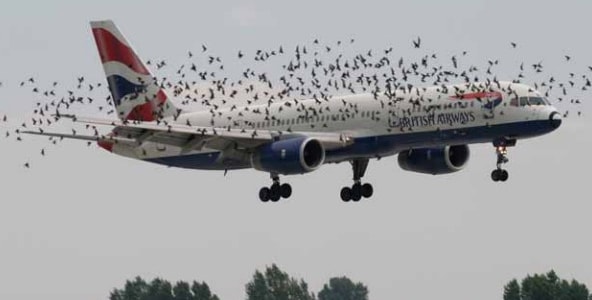‘Miracle on Hudson’ leads to new FAA rule on bird-strike testing

Photo of aircraft surrounded by birds from the FAA Wildlife Hazard Management at Airports manual
The FAA passed a final rule on a medium flocking bird test at climb condition, going into effect on June 5, stemming from the Jan. 15, 2009 incident when Flight 1549 in an Airbus A320 struck a flock of Canada geese and the engines suffered a total loss of thrust. The “miracle on the Hudson” in which Captain “Sully” Sullenberger ditched the plane on the Hudson River two minutes after takeoff and all 155 people on board were rescued with only a few serious injuries.
Flight 1549 occupants on the wings of the plane and slide/rafts after evacuation from NTSB report
The rule includes adding new test requirements for airworthiness regulation that addresses engine bird ingestion. The new requirement will ensure that turbofan engines can inject a large medium flocking bird (MFB) into the engine core during climb or approach conditions. Manufacturers must demonstrate that the engine core can continue to operate after ingesting an MFB while running at a lower fan speed, which is associated with climb or approach.
New testing will require ingesting the equivalent of one MFB, the largest bird required for testing, in either climb or approach conditions. The test bird will be fired at 261-knots, or 250-knots indicated airspeed (KIAS), with a mechanical engine speed set at the lowest expected speed when climbing through 3,000 feet altitude above mean sea level (MSL) at International Standard Atmosphere (ISA) during standard day conditions. The engine must comply with new post-test requirements for large flocking birds but now, depending on the climb thrust of the engine, the engine may produce less than 50 percent of takeoff thrust during the first minute of ingestion.

If it is determined that no bird can enter the core during the test at climb condition, a separate test must be performed. The approach flocking bird test requires the bird to be fired at 209 knots (200-KIAS) with the mechanical engine speed at the lowest speed setting when descending through 3,000 feet MSL on approach. These applicants are required to comply with the post-test requirements that are the same as the last six minutes of the requirements for the large flocking bird test (LFB). Only the final six minutes are required as the plane will already be lined up on the runway.
The final rule will also allow the climb flocking bird test to be combined with the bird ingestion test when the climb first stage (fan) rotor speed is no more than three percent different from the first stage rotor speed. Manufacturers of plane engines that do not require the pilot to pull back on the throttle during climb can perform one less ingestion test. Birds are not required for testing, similarly sized objects can be used instead to meet the requirements.

When birds are ingested by the engine, the amount of bird material that enters the engine core depends on factors like the width of the fan blade chord, airplane speed and the rotational speed of the fan blades. A higher fan speed lowers the likelihood of the bird material entering the core while a lower speed increases the chances. The previous bird ingestion tests were conducted using 100 percent power or thrust at the most critical airspeed of up to 1,500 feet AGL. The test did not account for lower fan speed phases of flight like the climb and descent when it is more likely the bird will enter the engine core.
The previous testing was found to not provide a full demonstration of the engine core durability against bird ingestion for the climb and approach conditions. Following Flight 1549, the NTSB addressed several concerns in the investigative report, issuing two relevant engine-related safety recommendations to the FAA.
The NTSB issued safety recommendations regarding issues addressed by the FAA, U.S. Department of Agriculture and the European Aviation Safety Agency (EASA). Some safety concerns discussed in the report on the accident included in-flight engine diagnostics, engine bird-ingestion certification testing, emergency and abnormal checklist design, dual-engine failure and ditching training, training on the effects of flight envelope limitations on plane response to pilot inputs, the validation of operational procedures and requirements for airplane ditching certification and wildlife hazard mitigation.

The NTSB had found the cause was the ingestion of large birds into each engine causing a total loss of thrust in both engines, forcing the captain to ditch the plane on the river. Ditching is the act of landing a plane on a body of water in an emergent situation. Multiple factors contributed to fuselage damage and resulted in the unavailability of the aft slide/rafts. The FAA had approved ditching certification without determining if the pilots could attain the ditching parameters without engine thrust. The NTSB found there was a lack of industry flight crew training and guidance on ditching techniques and the difficulty the captain had in maintaining the intended airspeed on the final approach due to “task saturation resulting from the emergency situation.”
When adopting the new final rule, the FAA received comments from Pratt & Whitney, The Boeing Company, General Electric, Rolls-Royce, Air Line Pilots Association, International (ALPA) and the NTSB. Most commenters supported the proposed rule and a few requested small changes. Many requested the combination of the new climb flocking bird test with the existing MFB test if the difference between climb and takeoff fan rotor speeds is no more than three percent and the FAA agreed.

The FAA believes the bill will not have a negative economic impact on small businesses or engine manufacturers, but will have a slight net benefit based on a study of 27 years of data.

The proposed rule was published initially on July 6, 2018. The first powered flight by the Wright brothers occurred in December 1903 and according to the FAA, the first reported bird strike was Sept. 7, 1905. The first reported mammal strike was on July 25, 1909. The first person to fly across the continental USA, Calbraith Rodgers, was also the first person to die as a result of a wildlife strike when his aircraft hit a gull along the coast on April 3, 1912. Wildlife hazards can have deadly and damaging results and the hope is that this new rule will improve safety and mitigate the risks associated with bird strikes.
Contact
Name: Haley Davoren
, Digital Content Manager
Company: GlobalAir.com
Website: https://globalair.com
Email: [email protected]
Phone: 502-456-3934
©2023 GlobalAir.com, Haley Davoren. All rights reserved.

Recent Comments